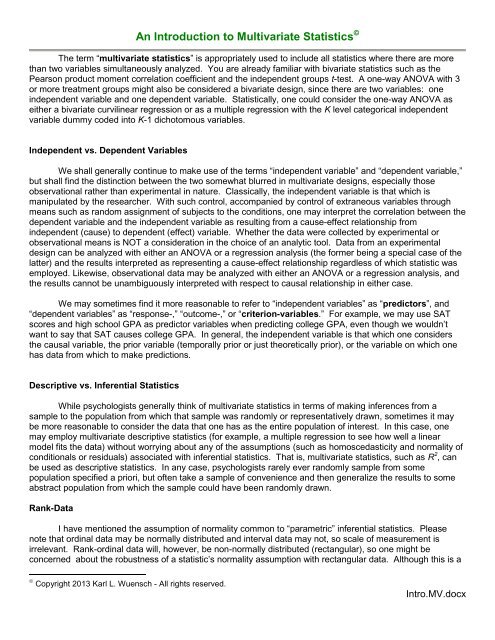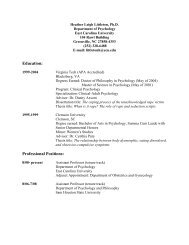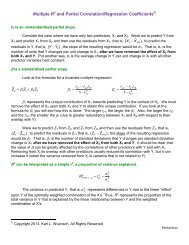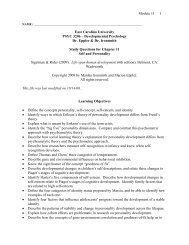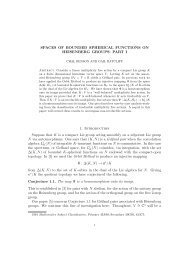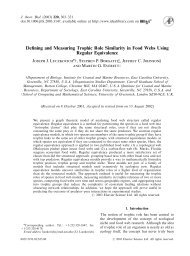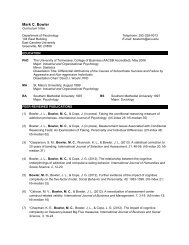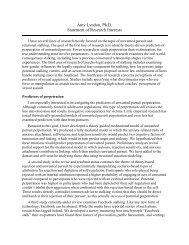AN INTRODUCTION TO MULTIVARIATE STATISTICS - Ecu
AN INTRODUCTION TO MULTIVARIATE STATISTICS - Ecu
AN INTRODUCTION TO MULTIVARIATE STATISTICS - Ecu
Create successful ePaper yourself
Turn your PDF publications into a flip-book with our unique Google optimized e-Paper software.
An Introduction to Multivariate Statistics <br />
The term “multivariate statistics” is appropriately used to include all statistics where there are more<br />
than two variables simultaneously analyzed. You are already familiar with bivariate statistics such as the<br />
Pearson product moment correlation coefficient and the independent groups t-test. A one-way <strong>AN</strong>OVA with 3<br />
or more treatment groups might also be considered a bivariate design, since there are two variables: one<br />
independent variable and one dependent variable. Statistically, one could consider the one-way <strong>AN</strong>OVA as<br />
either a bivariate curvilinear regression or as a multiple regression with the K level categorical independent<br />
variable dummy coded into K-1 dichotomous variables.<br />
Independent vs. Dependent Variables<br />
We shall generally continue to make use of the terms “independent variable” and “dependent variable,”<br />
but shall find the distinction between the two somewhat blurred in multivariate designs, especially those<br />
observational rather than experimental in nature. Classically, the independent variable is that which is<br />
manipulated by the researcher. With such control, accompanied by control of extraneous variables through<br />
means such as random assignment of subjects to the conditions, one may interpret the correlation between the<br />
dependent variable and the independent variable as resulting from a cause-effect relationship from<br />
independent (cause) to dependent (effect) variable. Whether the data were collected by experimental or<br />
observational means is NOT a consideration in the choice of an analytic tool. Data from an experimental<br />
design can be analyzed with either an <strong>AN</strong>OVA or a regression analysis (the former being a special case of the<br />
latter) and the results interpreted as representing a cause-effect relationship regardless of which statistic was<br />
employed. Likewise, observational data may be analyzed with either an <strong>AN</strong>OVA or a regression analysis, and<br />
the results cannot be unambiguously interpreted with respect to causal relationship in either case.<br />
We may sometimes find it more reasonable to refer to “independent variables” as “predictors”, and<br />
“dependent variables” as “response-,” “outcome-,” or “criterion-variables.” For example, we may use SAT<br />
scores and high school GPA as predictor variables when predicting college GPA, even though we wouldn’t<br />
want to say that SAT causes college GPA. In general, the independent variable is that which one considers<br />
the causal variable, the prior variable (temporally prior or just theoretically prior), or the variable on which one<br />
has data from which to make predictions.<br />
Descriptive vs. Inferential Statistics<br />
While psychologists generally think of multivariate statistics in terms of making inferences from a<br />
sample to the population from which that sample was randomly or representatively drawn, sometimes it may<br />
be more reasonable to consider the data that one has as the entire population of interest. In this case, one<br />
may employ multivariate descriptive statistics (for example, a multiple regression to see how well a linear<br />
model fits the data) without worrying about any of the assumptions (such as homoscedasticity and normality of<br />
conditionals or residuals) associated with inferential statistics. That is, multivariate statistics, such as R 2 , can<br />
be used as descriptive statistics. In any case, psychologists rarely ever randomly sample from some<br />
population specified a priori, but often take a sample of convenience and then generalize the results to some<br />
abstract population from which the sample could have been randomly drawn.<br />
Rank-Data<br />
I have mentioned the assumption of normality common to “parametric” inferential statistics. Please<br />
note that ordinal data may be normally distributed and interval data may not, so scale of measurement is<br />
irrelevant. Rank-ordinal data will, however, be non-normally distributed (rectangular), so one might be<br />
concerned about the robustness of a statistic’s normality assumption with rectangular data. Although this is a<br />
Copyright 2013 Karl L. Wuensch - All rights reserved.<br />
Intro.MV.docx
2<br />
controversial issue, I am moderately comfortable with rank data when there are twenty to thirty or more ranks<br />
in the sample (or in each group within the total sample).<br />
Why (and Why Not) Should One Use Multivariate Statistics<br />
One might object that psychologists got along OK for years without multivariate statistics. Why the<br />
sudden surge of interest in multivariate stats Is it just another fad Maybe it is. There certainly do remain<br />
questions that can be well answered with simpler statistics, especially if the data were experimentally<br />
generated under controlled conditions. But many interesting research questions are so complex that they<br />
demand multivariate models and multivariate statistics. And with the greatly increased availability of high<br />
speed computers and multivariate software, these questions can now be approached by many users via<br />
multivariate techniques formerly available only to very few. There is also an increased interest recently with<br />
observational and quasi-experimental research methods. Some argue that multivariate analyses, such as<br />
<strong>AN</strong>COV and multiple regression, can be used to provide statistical control of extraneous variables. While I<br />
opine that statistical control is a poor substitute for a good experimental design, in some situations it may be<br />
the only reasonable solution. Sometimes data arrive before the research is designed, sometimes experimental<br />
or laboratory control is unethical or prohibitively expensive, and sometimes somebody else was just plain<br />
sloppy in collecting data from which you still hope to distill some extract of truth.<br />
But there is danger in all this. It often seems much too easy to find whatever you wish to find in any<br />
data using various multivariate fishing trips. Even within one general type of multivariate analysis, such as<br />
multiple regression or factor analysis, there may be such a variety of “ways to go” that two analyzers may<br />
easily reach quite different conclusions when independently analyzing the same data. And one analyzer may<br />
select the means that maximize e’s chances of finding what e wants to find or e may analyze the data many<br />
different ways and choose to report only that analysis that seems to support e’s a priori expectations (which<br />
may be no more specific than a desire to find something “significant,” that is, publishable). Bias against the<br />
null hypothesis is very great.<br />
It is relatively easy to learn how to get a computer to do multivariate analysis. It is not so easy correctly<br />
to interpret the output of multivariate software packages. Many users doubtlessly misinterpret such output, and<br />
many consumers (readers of research reports) are being fed misinformation. I hope to make each of you a<br />
more critical consumer of multivariate research and a novice producer of such. I fully recognize that our<br />
computer can produce multivariate analyses that cannot be interpreted even by very sophisticated persons.<br />
Our perceptual world is three dimensional, and many of us are more comfortable in two dimensional space.<br />
Multivariate statistics may take us into hyperspace, a space quite different from that in which our brains (and<br />
thus our cognitive faculties) evolved.<br />
Categorical Variables and LOG LINEAR <strong>AN</strong>ALYSIS<br />
We shall consider multivariate extensions of statistics for designs where we treat all of the variables as<br />
categorical. You are already familiar with the bivariate (two-way) Pearson Chi-square analysis of contingency<br />
tables. One can expand this analysis into 3 dimensional space and beyond, but the log-linear model covered<br />
in Chapter 17 of Howell is usually used for such multivariate analysis of categorical data. As a example of<br />
such an analysis consider the analysis reported by Moore, Wuensch, Hedges, & Castellow in the Journal of<br />
Social Behavior and Personality, 1994, 9: 715-730. In the first experiment reported in this study mock jurors<br />
were presented with a civil case in which the female plaintiff alleged that the male defendant had sexually<br />
harassed her. The manipulated independent variables were the physical attractiveness of the defendant<br />
(attractive or not), and the social desirability of the defendant (he was described in the one condition as being<br />
socially desirable, that is, professional, fair, diligent, motivated, personable, etc., and in the other condition as<br />
being socially undesirable, that is, unfriendly, uncaring, lazy, dishonest, etc.) A third categorical independent<br />
variable was the gender of the mock juror. One of the dependent variables was also categorical, the verdict<br />
rendered (guilty or not guilty). When all of the variables are categorical, log-linear analysis is appropriate.<br />
When it is reasonable to consider one of the variables as dependent and the others as independent, as in this<br />
study, a special type of log-linear analysis called a LOGIT <strong>AN</strong>ALYSIS is employed. In the second experiment<br />
in this study the physical attractiveness and social desirability of the plaintiff were manipulated.
Earlier research in these authors’ laboratory had shown that both the physical attractiveness and the<br />
social desirability of litigants in such cases affect the outcome (the physically attractive and the socially<br />
desirable being more favorably treated by the jurors). When only physical attractiveness was manipulated<br />
(Castellow, Wuensch, & Moore, Journal of Social Behavior and Personality, 1990, 5: 547-562) jurors favored<br />
the attractive litigant, but when asked about personal characteristics they described the physically attractive<br />
litigant as being more socially desirable (kind, warm, intelligent, etc.), despite having no direct evidence about<br />
social desirability. It seems that we just assume that the beautiful are good. Was the effect on judicial<br />
outcome due directly to physical attractiveness or due to the effect of inferred social desirability When only<br />
social desirability was manipulated (Egbert, Moore, Wuensch, & Castellow, Journal of Social Behavior and<br />
Personality, 1992, 7: 569-579) the socially desirable litigants were favored, but jurors rated them as being more<br />
physically attractive than the socially undesirable litigants, despite having never seen them! It seems that we<br />
also infer that the bad are ugly. Was the effect of social desirability on judicial outcome direct or due to the<br />
effect on inferred physical attractiveness The 1994 study attempted to address these questions by<br />
simultaneously manipulating both social desirability and physical attractiveness.<br />
In the first experiment of the 1994 study it was found that the verdict rendered was significantly affected<br />
by the gender of the juror (female jurors more likely to render a guilty verdict), the social desirability of the<br />
defendant (guilty verdicts more likely with socially undesirable defendants), and a strange Gender x Physical<br />
Attractiveness interaction: Female jurors were more likely to find physically attractive defendants guilty, but<br />
male jurors’ verdicts were not significantly affected by the defendant’s physical attractiveness (but there was a<br />
nonsignificant trend for them to be more likely to find the unattractive defendant guilty). Perhaps female jurors<br />
deal more harshly with attractive offenders because they feel that they are using their attractiveness to take<br />
advantage of a woman.<br />
The second experiment in the 1994 study, in which the plaintiff’s physical attractiveness and social<br />
desirability were manipulated, found that only social desirability had a significant effect (guilty verdicts were<br />
more likely when the plaintiff was socially desirable). Measures of the strength of effect ( 2 ) of the<br />
independent variables in both experiments indicated that the effect of social desirability was much greater than<br />
any effect of physical attractiveness, leading to the conclusion that social desirability is the more important<br />
factor—if jurors have no information on social desirability, they infer social desirability from physical<br />
attractiveness and such inferred social desirability affects their verdicts, but when jurors do have relevant<br />
information about social desirability, litigants’ physical attractiveness is of relatively little importance.<br />
3<br />
Continuous Variables<br />
We shall usually deal with multivariate designs in which one or more of the variables is considered to<br />
be continuously distributed. We shall not nit-pick on the distinction between continuous and discrete variables,<br />
as I am prone to do when lecturing on more basic topics in statistics. If a discrete variable has a large number<br />
of values and if changes in these values can be reasonably supposed to be associated with changes in the<br />
magnitudes of some underlying construct of interest, then we shall treat that discrete variable as if it were<br />
continuous. IQ scores provide one good example of such a variable.<br />
C<strong>AN</strong>ONICAL CORRELATION/REGRESSION:<br />
Also known as multiple multiple regression or multivariate multiple regression. All other multivariate<br />
techniques may be viewed as simplifications or special cases of this “fully multivariate general linear model.”<br />
We have two sets of variables (set X and set Y). We wish to create a linear combination of the X variables<br />
(b 1 X 1 + b 2 X 2 + .... + b p X p ), called a canonical variate, that is maximally correlated with a linear combination of<br />
the Y variables (a 1 Y 1 + a 2 Y 2 + .... + a q Y q ). The coefficients used to weight the X’s and the Y’s are chosen with<br />
one criterion, maximize the correlation between the two linear combinations.
4<br />
As an example, consider the research reported by Patel, Long, McCammon, & Wuensch (Journal of<br />
Interpersonal Violence, 1995, 10: 354-366). We had two sets of data on a group of male college students.<br />
The one set was personality variables from the MMPI. One of these was the PD (psychopathically deviant)<br />
scale, Scale 4, on which high scores are associated with general social maladjustment and hostility. The<br />
second was the MF (masculinity/femininity) scale, Scale 5, on which low scores are associated with<br />
stereotypical masculinity † . The third was the MA (hypomania) scale, Scale 9, on which high scores are<br />
associated with overactivity, flight of ideas, low frustration tolerance, narcissism, irritability, restlessness,<br />
hostility, and difficulty with controlling impulses. The fourth MMPI variable was Scale K, which is a validity<br />
scale on which high scores indicate that the subject is “clinically defensive,” attempting to present himself in a<br />
favorable light, and low scores indicate that the subject is unusually frank. The second set of variables was a<br />
pair of homonegativity variables. One was the IAH (Index of Attitudes Towards Homosexuals), designed to<br />
measure affective components of homophobia. The second was the SBS, (Self-Report of Behavior Scale),<br />
designed to measure past aggressive behavior towards homosexuals, an instrument specifically developed for<br />
this study.<br />
With luck, we can interpret the weights (or, even better, the loadings, the correlations between each<br />
canonical variable and the variables in its set) so that each of our canonical variates represents some<br />
underlying dimension (that is causing the variance in the observed variables of its set). We may also think of<br />
a canonical variate as a superordinate variable, made up of the more molecular variables in its set. After<br />
constructing the first pair of canonical variates we attempt to construct a second pair that will explain as much<br />
as possible of the (residual) variance in the observed variables, variance not explained by the first pair of<br />
canonical variates. Thus, each canonical variate of the X’s is orthogonal to (independent of) each of the other<br />
canonical variates of the X’s and each canonical variate of the Y’s is orthogonal to each of the other canonical<br />
variates of the Y’s. Construction of canonical variates continues until you can no longer extract a pair of<br />
canonical variates that accounts for a significant proportion of the variance. The maximum number of pairs<br />
possible is the smaller of the number of X variables or number of Y variables.<br />
In the Patel et al. study both of the canonical correlations were significant. The first canonical<br />
correlation indicated that high scores on the SBS and the IAH were associated with stereotypical masculinity<br />
(low Scale 5), frankness (low Scale K), impulsivity (high Scale 9), and general social maladjustment and<br />
hostility (high Scale 4). The second canonical correlation indicated that having a low IAH but high SBS (not<br />
being homophobic but nevertheless aggressing against gays) was associated with being high on Scales 5 (not<br />
being stereotypically masculine) and 9 (impulsivity). The second canonical variate of the homonegativity<br />
variables seems to reflect a general (not directed towards homosexuals) aggressiveness.<br />
MULTIPLE REGRESSION<br />
In a standard multiple regression we have one continuous Y variable and two or more continuous X<br />
variables. Actually, the X variables may include dichotomous variables and/or categorical variables that have<br />
been “dummy coded” into dichotomous variables. The goal is to construct a linear model that minimizes error<br />
in predicting Y. That is, we wish to create a linear combination of the X variables that is maximally correlated<br />
with the Y variable. We obtain standardized regression coefficients ( weights <br />
Z Z Z <br />
Z<br />
Y 1 1 2 2 p p) that represent how large an “effect” each X has on Y above and beyond the<br />
effect of the other X’s in the model. The predictors may be entered all at once (simultaneous) or in sets of one<br />
or more (sequential). We may use some a priori hierarchical structure to build the model sequentially (enter<br />
first X 1 , then X 2 , then X 3 , etc., each time seeing how much adding the new X improves the model, or, start with<br />
all X’s, then first delete X 1 , then delete X 2 , etc., each time seeing how much deletion of an X affects the model).<br />
We may just use a statistical algorithm (one of several sorts of stepwise selection) to build what we hope is<br />
the “best” model using some subset of the total number of X variables available.<br />
For example, I may wish to predict college GPA from high school grades, SATV, SATQ, score on a<br />
“why I want to go to college” essay, and quantified results of an interview with an admissions officer. Since<br />
some of these measures are less expensive than others, I may wish to give them priority for entry into the<br />
model. I might also give more “theoretically important” variables priority. I might also include sex and race as
5<br />
predictors. I can also enter interactions between variables as predictors, for example, SATM x SEX, which<br />
would be literally represented by an X that equals the subject’s SATM score times e’s sex code (typically 0 vs.<br />
1 or 1 vs. 2). I may fit nonlinear models by entering transformed variables such as LOG(SATM) or SAT 2 . We<br />
shall explore lots of such fun stuff later.<br />
As an example of a multiple regression analysis, consider the research reported by McCammon,<br />
Golden, and Wuensch in the Journal of Research in Science Teaching, 1988, 25, 501-510. Subjects were<br />
students in freshman and sophomore level Physics courses (only those courses that were designed for<br />
science majors, no general education courses). The mission was to develop a model to<br />
predict performance in the course. The predictor variables were CT (the Watson-Glaser Critical Thinking<br />
Appraisal), PMA (Thurstone’s Primary Mental Abilities Test), ARI (the College Entrance Exam Board’s<br />
Arithmetic Skills Test), ALG (the College Entrance Exam Board’s Elementary Algebra Skills Test), and <strong>AN</strong>X<br />
(the Mathematics Anxiety Rating Scale). The criterion variable was subjects’ scores on course examinations.<br />
All of the predictor variables were significantly correlated with one another and with the criterion variable. A<br />
simultaneous multiple regression yielded a multiple R of .40 (which is more impressive if you consider that the<br />
data were collected across several sections of different courses with different instructors). Only ALG and CT<br />
had significant semipartial correlations (indicating that they explained variance in the criterion that was not<br />
explained by any of the other predictors). Both forward and backwards selection analyses produced a<br />
model containing only ALG and CT as predictors. At Susan McCammon’s insistence, I also separately<br />
analyzed the data from female and male students. Much to my surprise I found a remarkable sex difference.<br />
Among female students every one of the predictors was significantly related to the criterion, among male<br />
students none of the predictors was. There were only small differences between the sexes on variance in the<br />
predictors or the criterion, so it was not a case of there not being sufficient variability among the men to support<br />
covariance between their grades and their scores on the predictor variables. A posteriori searching of the<br />
literature revealed that Anastasi (Psychological Testing, 1982) had noted a relatively consistent finding of sex<br />
differences in the predictability of academic grades, possibly due to women being more conforming and more<br />
accepting of academic standards (better students), so that women put maximal effort into their studies,<br />
whether or not they like the course, and according they work up to their potential. Men, on the other hand, may<br />
be more fickle, putting forth maximum effort only if they like the course, thus making it difficult to predict their<br />
performance solely from measures of ability.<br />
LOGISTIC REGRESSION<br />
Logistic regression is used to predict a categorical (usually dichotomous) variable from a set of<br />
predictor variables. With a categorical dependent variable, discriminant function analysis is usually employed if<br />
all of the predictors are continuous and nicely distributed; logit analysis is usually employed if all of the<br />
predictors are categorical; and logistic regression is often chosen if the predictor variables are a mix of<br />
continuous and categorical variables and/or if they are not nicely distributed (logistic regression makes no<br />
assumptions about the distributions of the predictor variables). Logistic regression has been especially popular<br />
with medical research in which the dependent variable is whether or not a patient has a disease.<br />
For a logistic regression, the predicted dependent variable is the estimated probability that a particular<br />
subject will be in one of the categories (for example, the probability that Suzie Cue has the disease, given her<br />
set of scores on the predictor variables).<br />
As an example of the use of logistic regression in psychological research, consider the research done<br />
by Wuensch and Poteat and published in the Journal of Social Behavior and Personality, 1998, 13, 139-150.<br />
College students (N = 315) were asked to pretend that they were serving on a university research committee<br />
hearing a complaint against animal research being conducted by a member of the university faculty. Five<br />
different research scenarios were used: Testing cosmetics, basic psychological theory testing, agricultural<br />
(meat production) research, veterinary research, and medical research. Participants were asked to decide<br />
whether or not the research should be halted. An ethical inventory was used to measure participants’ idealism<br />
(persons who score high on idealism believe that ethical behavior will always lead only to good consequences,<br />
never to bad consequences, and never to a mixture of good and bad consequences) and relativism (persons
6<br />
who score high on relativism reject the notion of universal moral principles, preferring personal and situational<br />
analysis of behavior).<br />
Since the dependent variable was dichotomous (whether or not the respondent decided to halt the<br />
research) and the predictors were a mixture of continuous and categorical variables (idealism score, relativism<br />
score, participant’s gender, and the scenario given), logistic regression was employed. The scenario variable<br />
was represented by k1 dichotomous dummy variables, each representing the contrast between the medical<br />
scenario and one of the other scenarios. Idealism was negatively associated and relativism positively<br />
associated with support for animal research. Women were much less accepting of animal research than were<br />
men. Support for the theoretical and agricultural research projects was significantly less than that for the<br />
medical research.<br />
In a logistic regression, odds ratios are commonly employed to measure the strength of the partial<br />
relationship between one predictor and the dependent variable (in the context of the other predictor variables).<br />
It may be helpful to consider a simple univariate odds ratio first. Among the male respondents, 68 approved<br />
continuing the research, 47 voted to stop it, yielding odds of 68 / 47. That is, approval was 1.45 times more<br />
likely than nonapproval. Among female respondents, the odds were 60 / 140. That is, approval was only .43<br />
times as likely as was nonapproval. Inverting these odds (odds less than one are difficult for some people to<br />
comprehend), among female respondents nonapproval was 2.33 times as likely as approval. The ratio of<br />
68 47<br />
these odds, 3. 38, indicates that a man was 3.38 times more likely to approve the research than<br />
60 140<br />
was a woman.<br />
The odds ratios provided with the output from a logistic regression are for partial effects, that is, the<br />
effect of one predictor holding constant the other predictors. For our example research, the odds ratio for<br />
gender was 3.51. That is, holding constant the effects of all other predictors, men were 3.51 times more likely<br />
to approve the research than were women.<br />
The odds ratio for idealism was 0.50. Inverting this odds ratio for easier interpretation, for each one<br />
point increase on the idealism scale there was a doubling of the odds that the respondent would not approve<br />
the research. The effect of relativism was much smaller than that of idealism, with a one point increase on the<br />
nine-point relativism scale being associated with the odds of approving the research increasing by a<br />
multiplicative factor of 1.39. Inverted odds ratios for the dummy variables coding the effect of the scenario<br />
variable indicated that the odds of approval for the medical scenario were 2.38 times higher than for the meat<br />
scenario and 3.22 times higher than for the theory scenario.<br />
Classification: The results of a logistic regression can be used to predict into which group a subject<br />
will fall, given the subject’s scores on the predictor variables. For a set of scores on the predictor variables, the<br />
model gives you the estimated probability that a subject will be in group 1 rather than in group 2. You need a<br />
decision rule to determine into which group to classify a subject given that estimated probability. While the<br />
most obvious decision rule would be to classify the subject into group 1 if p > .5 and into group 2 if p < .5, you<br />
may well want to choose a different decision rule given the relative seriousness of making one sort of error (for<br />
example, declaring a patient to have the disease when she does not) or the other sort of error (declaring the<br />
patient not to have the disease when she does). For a given decision rule (for example, classify into group 1 if<br />
p > .7) you can compute several measures of how effective the classification procedure is. The Percent<br />
Correct is based on the number of correct classifications divided by the total number of classifications. The<br />
Sensitivity is the percentage of occurrences correctly predicted (for example, of all who actually have the<br />
disease, what percentage were correctly predicted to have the disease). The Specificity is the percentage of<br />
nonoccurrences correctly predicted (of all who actually are free of the disease, what percentage were correctly<br />
predicted not to have the disease). Focusing on error rates, the False Positive rate is the percentage of<br />
predicted occurrences which are incorrect (of all who were predicted to have the disease, what percentage<br />
actually did not have the disease), and the False Negative rate is the percentage of predicted nonoccurrences<br />
which are incorrect (of all who were predicted not to have the disease, what percentage actually did have the<br />
disease). For a screening test to detect a potentially deadly disease (such as breast cancer), you might be<br />
quite willing to use a decision rule that makes false positives fairly likely, but false negatives very unlikely. I
7<br />
understand that the false positive rate with mammograms is rather high. That is to be expected in an initial<br />
screening test, where the more serious error is the false negative. Although a false positive on a mammogram<br />
can certainly cause a woman some harm (anxiety, cost and suffering associated with additional testing), it may<br />
be justified by making it less likely that tumors will go undetected. Of course, a positive on a screening test is<br />
followed by additional testing, usually more expensive and more invasive, such as collecting tissue for biopsy.<br />
For our example research, the overall percentage correctly classified is 69% with a decision rule being<br />
“if p > .5, predict the respondent will support the research.” A slightly higher overall percentage correct (71%)<br />
would be obtained with the rule “if p > .4, predict support” (73% sensitivity, 70% specificity) or with the rule “if p<br />
> .54, predict support” (52% sensitivity, 84% specificity).<br />
HIERARCHICAL LINEAR MODELING<br />
Here you have data at two or more levels, with cases at one level nested within cases at at the next<br />
higher level. For example, you have pupils at the lowest level, nested within schools at the second level, with<br />
schools nested within school districts at the third level.<br />
You may have different variables at the different levels and you may be interested in relating variables<br />
to one another within levels and between levels.<br />
Consider the research conducted by Rowan et al. (1991). At the lowest level the cases were teachers.<br />
They provided ratings of the climate at the school (the “dependent” variables: Principal Leadership, Teacher<br />
Control , and Staff Cooperation) as well as data on Level 1 predictors such as race, sex, years of<br />
experience, and subject taught. Teachers were nested within schools. Level 2 predictors were whether the<br />
school was public or Catholic, its size, percentage minority enrollment, average student SES, and the like. At<br />
Level 1, ratings of the climate were shown to be related to the demographic characteristics of the teacher. For<br />
example, women thought the climate better than did men, and those teaching English, Science, and Math<br />
thought the climate worse than did those teaching in other domains. At Level 2, the type of school (public or<br />
Catholic) was related to ratings of climate, with climate being rated better at Catholic schools than at public<br />
schools.<br />
As another example, consider the analysis reported by Tabachnick and Fidell (2007, pp. 835-852),<br />
using data described in the article by Fidell et al. (1995). Participants from households in three different<br />
neighborhoods kept track of<br />
How annoyed they were by aircraft noise the previous night<br />
How long it took them to fall asleep the previous night<br />
How noisy it was at night (this was done by a noise-monitoring device in the home).<br />
At the lowest level, the cases were nights (data were collected across several nights). At the next level<br />
up the cases were the humans. Nights were nested within humans. At the next level up the cases were<br />
households. Humans were nested within households. Note that Level 1 represents a repeated measures<br />
dimension (nights).<br />
There was significant variability in annoyance both among humans and among households, and both<br />
sleep latency and noise level were significantly related to annoyance. The three different neighborhoods did<br />
not differ from each other on amount of annoyance.<br />
PRINCIPAL COMPONENTS <strong>AN</strong>D FAC<strong>TO</strong>R <strong>AN</strong>ALYSIS<br />
Here we start out with one set of variables. The variables are generally correlated with one another.<br />
We wish to reduce the (large) number of variables to a smaller number of components or factors (I’ll explain<br />
the difference between components and factors when we study this in detail) that capture most of the variance<br />
in the observed variables. Each factor (or component) is estimated as being a linear (weighted) combination of<br />
the observed variables. We could extract as many factors as there are variables, but generally most of them<br />
would contribute little, so we try to get a few factors that capture most of the variance. Our initial extraction<br />
generally includes the restriction that the factors be orthogonal, independent of one another.
8<br />
Consider the analysis reported by Chia, Wuensch, Childers, Chuang, Cheng, Cesar-Romero, & Nava<br />
in the Journal of Social Behavior and Personality, 1994, 9, 249-258. College students in Mexico, Taiwan, and<br />
the US completed a 45 item Cultural Values Survey. A principal components analysis produced seven<br />
components (each a linear combination of the 45 items) which explained in the aggregate 51% of the variance<br />
in the 45 items. We could have explained 100% of the variance with 45 components, but the purpose of the<br />
PCA is to explain much of the variance with relatively few components. Imagine a plot in seven dimensional<br />
space with seven perpendicular (orthogonal) axes. Each axis represents one component. For each variable I<br />
plot a point that represents its loading (correlation) with each component. With luck I’ll have seven “clusters” of<br />
dots in this hyperspace (one for each component). I may be able to improve my solution by rotating the axes<br />
so that each one more nearly passes through one of the clusters. I may do this by an orthogonal rotation<br />
(keeping the axes perpendicular to one another) or by an oblique rotation. In the latter case I allow the axes<br />
to vary from perpendicular, and as a result, the components obtained are no longer independent of one<br />
another. This may be quite reasonable if I believe the underlying dimensions (that correspond to the extracted<br />
components) are correlated with one another.<br />
With luck (or after having tried many different extractions/rotations), I’ll come up with a set of loadings<br />
that can be interpreted sensibly (that may mean finding what I expected to find). From consideration of which<br />
items loaded well on which components, I named the components Family Solidarity (respect for the family),<br />
Executive Male (men make decisions, women are homemakers), Conscience (important for family to conform<br />
to social and moral standards), Equality of the Sexes (minimizing sexual stereotyping), Temporal<br />
Farsightedness (interest in the future and the past), Independence (desire for material possessions and<br />
freedom), and Spousal Employment (each spouse should make decisions about his/her own job). Now, using<br />
weighting coefficients obtained with the analysis, I computed for each subject a score that estimated how much<br />
of each of the seven dimensions e had. These component scores were then used as dependent variables in<br />
3 x 2 x 2, Culture x Sex x Age (under 20 vs. over 20) <strong>AN</strong>OVAs. US students (especially the women) stood out<br />
as being sexually egalitarian, wanting independence, and, among the younger students, placing little<br />
importance on family solidarity. The Taiwanese students were distinguished by scoring very high on the<br />
temporal farsightedness component but low on the conscience component. Among Taiwanese students the<br />
men were more sexually egalitarian than the women and the women more concerned with independence than<br />
were the men. The Mexican students were like the Taiwanese in being concerned with family solidarity but not<br />
with sexual egalitarianism and independence, but like the US students in attaching more importance to<br />
conscience and less to temporal farsightedness. Among the Mexican students the men attached more<br />
importance to independence than did the women.<br />
Factor analysis also plays a prominent role in test construction. For example, I factor analyzed<br />
subjects’ scores on the 21 items in Patel’s SBS discussed earlier. Although the instrument was designed to<br />
measure a single dimension, my analysis indicated that three dimensions were being measured. The first<br />
factor, on which 13 of the items loaded well, seemed to reflect avoidance behaviors (such as moving away<br />
from a gay, staring to communicate disapproval of proximity, and warning gays to keep away). The second<br />
factor (six items) reflected aggression from a distance (writing anti-gay graffiti, damaging a gay’s property,<br />
making harassing phone calls). The third factor (two items) reflected up-close aggression (physical fighting).<br />
Despite this evidence of three factors, item analysis indicated that the instrument performed well as a measure<br />
of a single dimension. Item-total correlations were good for all but two items. Cronbach’s alpha was .91, a<br />
value which could not be increased by deleting from the scale any of the items. Cronbach’s alpha is<br />
considered a measure of the reliability or internal consistency of an instrument. It can be thought of as the<br />
mean of all possible split-half reliability coefficients (correlations between scores on half of the items vs. the<br />
other half of the items, with the items randomly split into halves) with the Spearman-Brown correction (a<br />
correction for the reduction in the correlation due to having only half as many items contributing to each score<br />
used in the split-half reliability correlation coefficient—reliability tends to be higher with more items, ceteris<br />
paribus). Please read the document Cronbach's Alpha and Maximized Lambda4. Follow the instructions there to<br />
conduct an item analysis with SAS and with SPSS. Bring your output to class for discussion.
STRUCTURAL EQUATION MODELING (SEM)<br />
9<br />
This is a special form of hierarchical multiple regression analysis in which the researcher specifies a<br />
particular causal model in which each variable affects one or more of the other variables both directly and<br />
through its effects upon intervening variables. The less complex models use only unidirectional paths (if X 1<br />
has an effect on X 2 , then X 2 cannot have an effect on X 1 ) and include only measured variables. Such an<br />
analysis is referred to as a path analysis. Patel’s data, discussed earlier, were originally analyzed (in her<br />
thesis) with a path analysis. The model was that the MMPI scales were noncausally correlated with one<br />
another but had direct causal effects on both IAH and SBS, with IAH having a direct causal effect on SBS. The<br />
path analysis was not well received by reviewers the first journal to which we sent the manuscript, so we<br />
reanalyzed the data with the atheoretical canonical<br />
correlation/regression analysis presented earlier and submitted it<br />
elsewhere. Reviewers of that revised manuscript asked that we<br />
supplement the canonical correlation/regression analysis with a<br />
hierarchical multiple regression analysis (essentially a path<br />
analysis).<br />
In a path analysis one obtains path coefficients, measuring<br />
the strength of each path (each causal or noncausal link between<br />
one variable and another) and one assesses how well the model fits<br />
the data. The arrows from ‘e’ represent error variance (the effect of<br />
variables not included in the model). One can compare two<br />
different models and determine which one better fits the data. Our<br />
analysis indicated that the only significant paths were from MF to IAH (–.40) and from MA (.25) and IAH (.4) to<br />
SBS.<br />
SEM can include latent variables (factors), constructs that are not directly measured but rather are<br />
inferred from measured variables (indicators).<br />
The relationships between latent variables are referred to as the structural part of a model (as opposed<br />
to the measurement part, which is the relationship between latent variables and measured variables). As an<br />
example of SEM including latent variables, consider the research by Greenwald and Gillmore (Journal of<br />
Educational Psychology, 1997, 89, 743-751) on the validity of student ratings of instruction (check out my<br />
review of this research). Their analysis indicated that when students expect to get better grades in a class they<br />
work less on that class and evaluate the course and the instructor more favorably. The indicators (measured<br />
variables) for the Workload latent variable were questions about how much time the students spent on the<br />
course and how challenging it was. Relative expected grade (comparing the grade expected in the rated<br />
course with that the student usually got in other courses) was a more important indicator of the Expected<br />
Grade latent variable than was absolute expected grade. The Evaluation latent variable was indicated by<br />
questions about challenge, whether or not the student would take this course with the same instructor if e had<br />
it to do all over again, and assorted items about desirable characteristics of the instructor and course.<br />
Greenwald’s research suggests that instructors who have lenient grading policies will get good<br />
evaluations but will not motivate their students to work hard enough to learn as much as they do with<br />
instructors whose less lenient grading policies lead to more work but less favorable evaluations.<br />
I am rather skeptical with respect to SEM. Part of my reluctance to embrace SEM stems from my not<br />
being comfortable with the notion that showing good fit between an observed correlation matrix and one’s<br />
theoretical model really “confirms” that model. It is always quite possible that an untested model would fit the<br />
data as well or better than the tested model.
10<br />
Workload<br />
.57<br />
Hours Worked per<br />
Credit Hour<br />
Relative<br />
Expected<br />
Grade<br />
.98<br />
–.49 .75<br />
Expected<br />
Grade<br />
Intellectual Challenge<br />
Absolute<br />
Expected<br />
Grade<br />
.70<br />
.44 .53<br />
Take Same Instructor Again<br />
Evaluation<br />
.93<br />
.90<br />
Characteristics of Instructor & Course<br />
Confirmatory factor analysis can be considered a special case of SEM. In confirmatory factor<br />
analysis the focus is on testing an a priori model of the factor structure of a group of measured variables.<br />
Tabachnick and Fidell (5 th edition) present an example (pages 732 - 749) in which the tested model<br />
hypothesizes that intelligence in learning disabled children, as estimated by the WISC, can be represented by<br />
two factors (possibly correlated with one another) with a particular simple structure (relationship between the<br />
indicator variables and the factors).<br />
DISCRIMIN<strong>AN</strong>T FUNCTION <strong>AN</strong>ALYSIS<br />
You wish to predict group membership from a set of two or more continuous variables. The analysis<br />
creates a set of discriminant functions (weighted combinations of the predictors) that will enable you to<br />
predict into which group a case falls, based on scores on the predictor variables (usually continuous, but<br />
could include dichotomous variables and dummy coded categorical predictors). The total possible number of<br />
discriminant functions is one less than the number of groups, or the number of predictor variables, whichever is<br />
less. Generally only a few of the functions will do a good job of discriminating group membership. The second<br />
function, orthogonal to the first, analyses variance not already captured by the first, the third uses the residuals<br />
from the first and second, etc. One may think of the resulting functions as dimensions on which the groups<br />
differ, but one must remember that the weights are chosen to maximize the discrimination among groups,<br />
not to make sense to you. Standardized discriminant function coefficients (weights) and loadings<br />
(correlations between discriminant functions and predictor variables) may be used to label the functions. One<br />
might also determine how well a function separates each group from all the rest to help label the function. It is<br />
possible to do hierarchical/stepwise analysis and factorial (more than one grouping variable) analysis.<br />
Consider what the IRS does with the data they collect from “random audits” of taxpayers. From each<br />
taxpayer they collect data on a number of predictor variables (gross income, number of exemptions, amount of<br />
deductions, age, occupation, etc.) and one classification variable, is the taxpayer a cheater (underpaid e’s<br />
taxes) or honest. From these data they develop a discriminant function model to predict whether or not a
11<br />
return is likely fraudulent. Next year their computers automatically test every return, and if yours fits the<br />
profile of a cheater you are called up for a “discriminant analysis” audit. Of course, the details of the model are<br />
a closely guarded secret, since if a cheater knew the discriminant function e could prepare his return with the<br />
maximum amount of cheating that would result in e’s (barely) not being classified as a cheater.<br />
As another example, consider the research done by Poulson, Braithwaite, Brondino, and Wuensch<br />
(1997, Journal of Social Behavior and Personality, 12, 743-758). Subjects watched a simulated trial in which<br />
the defendant was accused of murder and was pleading insanity. There was so little doubt about his having<br />
killed the victim that none of the jurors voted for a verdict of not guilty. Aside from not guilty, their verdict<br />
options were Guilty, NGRI (not guilty by reason of insanity), and GBMI (guilty but mentally ill). Each mock juror<br />
filled out a questionnaire, answering 21 questions (from which 8 predictor variables were constructed) about<br />
e’s attitudes about crime control, the insanity defense, the death penalty, the attorneys, and e’s assessment of<br />
the expert testimony, the defendant’s mental status, and the possibility that the defendant could be<br />
rehabilitated. To avoid problems associated with multicollinearity among the 8 predictor variables (they were<br />
very highly correlated with one another, and such multicollinearity can cause problems in a multivariate<br />
analysis), the scores on the 8 predictor variables were subjected to a principal components analysis, with the<br />
resulting orthogonal components used as predictors in a discriminant analysis. The verdict choice (Guilty,<br />
NGRI, or GBMI) was the criterion variable.<br />
Both of the discriminant functions were significant. The first function discriminated between jurors<br />
choosing a guilty verdict and subjects choosing a NGRI verdict. Believing that the defendant was mentally ill,<br />
believing the defense’s expert testimony more than the prosecution’s, being receptive to the insanity defense,<br />
opposing the death penalty, believing that the defendant could be rehabilitated, and favoring lenient treatment<br />
were associated with rendering a NGRI verdict. Conversely, the opposite orientation on these factors was<br />
associated with rendering a guilty verdict. The second function separated those who rendered a GBMI verdict<br />
from those choosing Guilty or NGRI. Distrusting the attorneys (especially the prosecution attorney), thinking<br />
rehabilitation likely, opposing lenient treatment, not being receptive to the insanity defense, and favoring the<br />
death penalty were associated with rendering a GBMI verdict rather than a guilty or NGRI verdict.<br />
MULTIPLE <strong>AN</strong>ALYSIS OF VARI<strong>AN</strong>CE, M<strong>AN</strong>OVA<br />
This is essentially a DFA turned around. You have two or more continuous Y’s and one or more<br />
categorical X’s. You may also throw in some continuous X’s (covariates, giving you a M<strong>AN</strong>COVA, multiple<br />
analysis of covariance). The most common application of M<strong>AN</strong>OVA in psychology is as a device to guard<br />
against inflation of familywise alpha when there are multiple dependent variables. The logic is the same as<br />
that of the protected t-test, where an omnibus <strong>AN</strong>OVA on your K-level categorical X must be significant before<br />
you make pairwise comparisons among your K groups’ means on Y. You do a M<strong>AN</strong>OVA on your multiple Y’s.<br />
If it is significant, you may go on and do univariate <strong>AN</strong>OVAs (one on each Y), if not, you stop. In a factorial<br />
analysis, you may follow-up any effect which is significant in the M<strong>AN</strong>OVA by doing univariate analyses for<br />
each such effect.<br />
As an example, consider the M<strong>AN</strong>OVA I did with data from a simulated jury trial with Taiwanese<br />
subjects (see Wuensch, Chia, Castellow, Chuang, & Cheng, Journal of Cross-Cultural Psychology, 1993, 24,<br />
414-427). The same experiment had earlier been done with American subjects. X’s consisted of whether or<br />
not the defendant was physically attractive, sex of the defendant, type of alleged crime (swindle or burglary),<br />
culture of the defendant (American or Chinese), and sex of subject (juror). Y’s consisted of length of sentence<br />
given the defendant, rated seriousness of the crime, and ratings on 12 attributes of the defendant. I did two<br />
M<strong>AN</strong>OVAs, one with length of sentence and rated seriousness of the crime as Y’s, one with ratings on the 12<br />
attributes as Y’s. On each I first inspected the M<strong>AN</strong>OVA. For each effect (main effect or interaction) that was<br />
significant on the M<strong>AN</strong>OVA, I inspected the univariate analyses to determine which Y’s were significantly<br />
associated with that effect. For those that were significant, I conducted follow-up analyses such as simple<br />
interaction analyses and simple main effects analyses. A brief summary of the results follows: Female<br />
subjects gave longer sentences for the crime of burglary, but only when the defendant was American;<br />
attractiveness was associated with lenient sentencing for American burglars but with stringent sentencing for<br />
American swindlers (perhaps subjects thought that physically attractive swindlers had used their attractiveness
12<br />
in the commission of the crime and thus were especially deserving of punishment); female jurors gave more<br />
lenient sentences to female defendants than to male defendants; American defendants were rated more<br />
favorably (exciting, happy, intelligent, sociable, strong) than were Chinese defendants; physically attractive<br />
defendants were rated more favorably (attractive, calm, exciting, happy, intelligent, warm) than were physically<br />
unattractive defendants; and the swindler was rated more favorably (attractive, calm, exciting, independent,<br />
intelligent, sociable, warm) than the burglar.<br />
In M<strong>AN</strong>OVA the Y’s are weighted to maximize the correlation between their linear combination and the<br />
X’s. A different linear combination (canonical variate) is formed for each effect (main effect or interaction—in<br />
fact, a different linear combination is formed for each treatment df—thus, if an independent variable consists<br />
of four groups, three df, there are three different linear combinations constructed to represent that effect, each<br />
orthogonal to the others). Standardized discriminant function coefficients (weights for predicting X from<br />
the Y’s) and loadings (for each linear combination of Y’s, the correlations between the linear combination and<br />
the Y’s themselves) may be used better to define the effects of the factors and their interactions. One may<br />
also do a “stepdown analysis” where one enters the Y’s in an a priori order of importance (or based solely on<br />
statistical criteria, as in stepwise multiple regression). At each step one evaluates the contribution of the newly<br />
added Y, above and beyond that of the Y’s already entered.<br />
As an example of an analysis which uses more of the multivariate output than was used with the<br />
example two paragraphs above, consider again the research done by Moore, Wuensch, Hedges, and<br />
Castellow (1994, discussed earlier under the topic of log-linear analysis). Recall that we manipulated the<br />
physical attractiveness and social desirability of the litigants in a civil case involving sexual harassment. In<br />
each of the experiments in that study we had subjects fill out a rating scale, describing the litigant (defendant or<br />
plaintiff) whose attributes we had manipulated. This analysis was essentially a manipulation check, to verify<br />
that our manipulations were effective. The rating scales were nine-point scales, for example,<br />
Awkward<br />
Poised<br />
1 2 3 4 5 6 7 8 9<br />
There were 19 attributes measured for each litigant. The data from the 19 variables were used as<br />
dependent variables in a three-way M<strong>AN</strong>OVA (social desirability manipulation, physical attractiveness<br />
manipulation, gender of subject). In the first experiment, in which the physical attractiveness and social<br />
desirability of the defendant were manipulated, the M<strong>AN</strong>OVA produced significant effects for the social<br />
desirability manipulation and the physical attractiveness manipulation, but no other significant effects. The<br />
canonical variate maximizing the effect of the social desirability manipulation loaded most heavily (r > .45) on<br />
the ratings of sociability (r = .68), intelligence (r = .66), warmth (r = .61), sensitivity (r = .50), and kindness (r =<br />
.49). Univariate analyses indicated that compared to the socially undesirable defendant, the socially desirable<br />
defendant was rated significantly more poised, modest, strong, interesting, sociable, independent, warm,<br />
genuine, kind, exciting, sexually warm, secure, sensitive, calm, intelligent, sophisticated, and happy. Clearly<br />
the social desirability manipulation was effective.<br />
The canonical variate that maximized the effect of the physical attractiveness manipulation loaded<br />
heavily only on the physical attractiveness ratings (r = .95), all the other loadings being less than .35. The<br />
mean physical attractiveness ratings were 7.12 for the physically attractive defendant and 2.25 for the<br />
physically unattractive defendant. Clearly the physical attractiveness manipulation was effective. Univariate<br />
analyses indicated that this manipulation had significant effects on several of the ratings variables. Compared<br />
to the physically unattractive defendant, the physically attractive defendant was rated significantly more poised,<br />
strong, interesting, sociable, physically attractive, warm, exciting, sexually warm, secure, sophisticated, and<br />
happy.<br />
In the second experiment, in which the physical attractiveness and social desirability of the plaintiff<br />
were manipulated, similar results were obtained. The canonical variate maximizing the effect of the social<br />
desirability manipulation loaded most heavily (r > .45) on the ratings of intelligence (r = .73), poise (r = .68),<br />
sensitivity (r = .63), kindness (r = .62), genuineness (r = .56), warmth (r = .54), and sociability (r = .53).<br />
Univariate analyses indicated that compared to the socially undesirable plaintiff the socially desirable plaintiff<br />
was rated significantly more favorably on all nineteen of the adjective scale ratings.
The canonical variate that maximized the effect of the physical attractiveness manipulation loaded<br />
heavily only on the physical attractiveness ratings (r = .84), all the other loadings being less than .40. The<br />
mean physical attractiveness ratings were 7.52 for the physically attractive plaintiff and 3.16 for the physically<br />
unattractive plaintiff. Univariate analyses indicated that this manipulation had significant effects on several of<br />
the ratings variables. Compared to the physically unattractive plaintiff the physically attractive plaintiff was<br />
rated significantly more poised, interesting, sociable, physically attractive, warm, exciting, sexually warm,<br />
secure, sophisticated, and happy.<br />
13<br />
LEAST SQUARES <strong>AN</strong>OVA<br />
An <strong>AN</strong>OVA may be done as a multiple regression, with the categorical X’s coded as “dummy variables.”<br />
A K-level X is represented by K-1 dichotomous dummy variables. An interaction between two X’s is<br />
represented by products of the main effects X’s. For example, were factors A and B both dichotomous, we<br />
could code A with X 1 (0 or 1), B with X 2 (0 or 1), and A x B with X 3 , where X 3 equals X 1 times X 2 . Were A<br />
dichotomous and B had three levels, the main effect of B would require two dummy variables, X 2 and X 3 , and<br />
the A x B interaction would require two more dummy variables, X 4 (the product of X 1 and X 2 ) and X 5 (the<br />
product of X 1 and X 3 ). [Each effect will require as many dummy variables as the df it has.] In the multiple<br />
regression the SS due to X 1 would be the SS A , the SS B would be the combined SS for X 2 and X 3 , and the<br />
interaction SS would be the combined SS for X 4 and X 5 . There are various ways we can partition the SS, but<br />
we shall generally want to use Overall and Spiegel’s Method I, where each effect is partialled for all other<br />
effects. That is, for example, SS A is the SS that is due solely to A (the increase in the SS reg when we added<br />
A’s dummy variable(s) to a model that already includes all other effects). Any variance in Y that is ambiguous<br />
(could be assigned to more than one effect) is disregarded. There will, of course, be such ambiguous variance<br />
only when the independent variables are nonorthogonal (correlated, as indicated by the unequal cell sizes).<br />
Overall and Spiegel’s Method I least-squares <strong>AN</strong>OVA is the method that is approximated by the “by hand”<br />
unweighted means <strong>AN</strong>OVA that you learned earlier.<br />
<strong>AN</strong>COV<br />
In the analysis of covariance you enter one or more covariates (usually continuous, but may be<br />
dummy coded categorical variables) into the multiple correlation before or at the same time that you enter<br />
categorical predictor variables (dummy codes). The effect of each factor or interaction is the increase in the<br />
SS reg when that factor is added to a model that already contains all of the other factors and interactions and all<br />
of the covariates.<br />
In the ideal circumstance, you have experimentally manipulated the categorical variables (independent<br />
variables), randomly assigned subjects to treatments, and measured the covariate(s) prior to the manipulation<br />
of the independent variable. In this case, the inclusion of the covariate(s) in the model will reduce what would<br />
otherwise be error in the model, and this can greatly increase the power of your analysis. Consider the<br />
following partitioning of the sums of squares of post-treatment wellness scores. The Treatment variable is<br />
Type of Therapy used with your patients, three groups. The F ratio testing the treatment will be the ratio of the<br />
Treatment Mean Square to the Error Mean Square.<br />
Sums of Squares<br />
Treatment<br />
Error
14<br />
Your chances of getting a significant result are going to be a lot better if you can do something to<br />
reduce the size of the error variance, which goes into the denominator of the F ratio. Reducing the size of the<br />
Mean Square Error (the denominator of the F ratio) will increase the value of F and lower the p value.<br />
Suppose you find that you have, for each of your subjects, a score on the wellness measure taken prior to the<br />
treatment. Those baseline scores are likely well correlated with the post-treatment scores. You add the<br />
baseline wellness to the model. – that is, baseline wellness becomes a covariate.<br />
Sum of Squares<br />
Treatment<br />
Baseline<br />
Error<br />
Wow! You have cut the error in half. This will greatly increase the value of the F testing the effect of<br />
the treatment. In statistics, getting a big F is generally a good thing, as it leads to significant results.<br />
Now you discover that you also have, for each subject, a pre-treatment measure of blood levels of<br />
scatophobin, a neurohormone thought to be associated with severity of the treated illness. You now include<br />
that as a second covariate.<br />
Sum of Squares<br />
Treatment<br />
Baseline<br />
Scatophobin<br />
Error<br />
Double WOW! You have reduced the error variance even more, gaining additional power and<br />
additional precision with respect to your estimates of effect sizes (tighter confidence intervals).<br />
If your categorical predictor variables are correlated with the covariate(s), then removing the<br />
effects of the covariates may also remove some of the effects of the factors, which may not be what you<br />
wanted to do. Such a confounding of covariates with categorical predictors often results from:<br />
subjects not being randomly assigned to treatments<br />
the covariates being measured after the manipulations of the independent variables(s) -- and those<br />
manipulations changed subjects’ scores on the covariates<br />
the categorical predictors being nonexperimental (not manipulated),<br />
Typically the psychologist considers the continuous covariates to be nuisance variables, whose effects<br />
are to be removed prior to considering the effects of categorical predictor variables. The same model can be<br />
used to predict scores on a continuous outcome variable from a mixture of continuous and categorical<br />
predictor variables, even when the researcher does not consider the continuous covariates to be nuisance<br />
variables. For example, consider the study by Wuensch and Poteat discussed earlier as an example of logistic<br />
regression. A second dependent variable was respondents’ scores on a justification variable (after reading the<br />
case materials, each participant was asked to rate on a 9-point scale how justified the research was, from “not<br />
at all” to “completely”). We used an <strong>AN</strong>COV model to predict justification scores from idealism, relativism,<br />
gender, and scenario. Although the first two predictors were continuous (“covariates”), we did not consider
them to be nuisance variables, we had a genuine interest in their relationship with the dependent variable.<br />
A brief description of the results of the <strong>AN</strong>COV follows:<br />
15<br />
There were no significant interactions between predictors, but each predictor had a significant main<br />
effect. Idealism was negatively associated with justification, = 0.32, r = 0.36, F(1, 303) = 40.93, p < .001,<br />
relativism was positively associated with justification, = .20, r = .22, F(1, 303) = 15.39, p < .001, mean<br />
justification was higher for men (M = 5.30, SD = 2.25) than for women (M = 4.28, SD = 2.21), F(1, 303) =<br />
13.24, p < .001, and scenario had a significant omnibus effect, F(4, 303) = 3.61, p = .007. Using the medical<br />
scenario as the reference group, the cosmetic and the theory scenarios were found to be significantly less<br />
justified.<br />
<strong>MULTIVARIATE</strong> APPROACH <strong>TO</strong> REPEATED MEASURES <strong>AN</strong>OVA<br />
An <strong>AN</strong>OVA may include one or more categorical predictors for which the groups are not independent.<br />
Subjects may be measured at each level of the treatment variable (repeated measures, within-subjects).<br />
Alternatively, subjects may be blocked on the basis of variables known to be related to the dependent variable<br />
and then, within each block, randomly assigned to treatments (the randomized blocks or split-plot design). In<br />
either case, a repeated measures <strong>AN</strong>OVA may be appropriate if the dependent variable is normally distributed<br />
and other assumptions are met.<br />
The traditional repeated measures analyses of variance (aka “univariate approach”) has a sphericity<br />
assumption: the standard error of the difference between pairs of means is constant across all pairs of<br />
means. That is, for comparing the mean at any one level of the repeated factor versus any other level of the<br />
repeated factor, the diff is the same as it would be for any other pair of levels of the repeated factor. Howell<br />
(page 443 of the 6 th edition of Statistical Methods for Psychology) discusses compound symmetry, a<br />
somewhat more restrictive assumption. There are adjustments (of degrees of freedom) to correct for violation<br />
of the sphericity assumption, but at a cost of lower power.<br />
A more modern approach, the multivariate approach to repeated measures designs, does not have<br />
such a sphericity assumption. In the multivariate approach the effect of a repeated measures dimension (for<br />
example, whether this score represents Suzie Cue’s headache duration during the first, second, or third week<br />
of treatment) is coded by computing k1 difference scores (one for each degree of freedom for the repeated<br />
factor) and then treating those difference scores as dependent variables in a M<strong>AN</strong>OVA.<br />
You are already familiar with the basic concepts of main effects, interactions, and simple effects from<br />
our study of independent samples <strong>AN</strong>OVA. We remain interested in these same sorts of effects in <strong>AN</strong>OVA<br />
with repeated measures, but we must do the analysis differently. While it might be reasonable to conduct such<br />
an analysis by hand when the design is quite simple, typically computer analysis will be employed.<br />
If your <strong>AN</strong>OVA design has one or more repeated factors and multiple dependent variables, then you<br />
can do a doubly multivariate analysis, with the effect of the repeated factor being represented by a set of<br />
k1 difference scores for each of the two or more dependent variables. For example, consider my study on the<br />
effects of cross-species rearing of house mice (Animal Learning & Behavior, 1992, 20, 253-258). Subjects<br />
were house mice that had been reared by house mice, deer mice, or Norway rats. The species of the foster<br />
mother was a between-subjects (independent samples) factor. I tested them in an apparatus where they could<br />
visit four tunnels: One scented with clean pine shavings, one scented with the smell of house mice, one<br />
scented with the smell of deer mice, and one scented with the smell of rats. The scent of the tunnel was a<br />
within-subjects factor, so I had a mixed factorial design (one or more between-subjects factor, one or more<br />
within-subjects factor). I had three dependent variables: The latency until the subject first entered each tunnel,<br />
how many visits the subject made to each tunnel, and how much time each subject spent in each tunnel.<br />
Since the doubly multivariate analysis indicated significant effects (interaction between species of the foster<br />
mother and scent of the tunnel, as well as significant main effects of each factor), singly multivariate <strong>AN</strong>OVA<br />
(that is, on one dependent variable at a time, but using the multivariate approach to code the repeated factor)<br />
was conducted on each dependent variable (latency, visits, and time). The interaction was significant for each
16<br />
dependent variable, so simple main effects analyses were conducted. The basic finding (somewhat<br />
simplified here) was that with respect to the rat-scented tunnel, those subjects who had been reared by a rat<br />
had shorter latencies to visit the tunnel, visited that tunnel more often, and spent more time in that tunnel. If<br />
you consider that rats will eat house mice, it makes good sense for a house mouse to be disposed not to enter<br />
tunnels that smell like rats. Of course, my rat-reared mice may have learned to associate the smell of rat with<br />
obtaining food (nursing from their rat foster mother) rather than being food!<br />
CLUSTER <strong>AN</strong>ALYSIS<br />
In a cluster analysis the goal is to cluster cases (research units) into groups that share similar<br />
characteristics. Contrast this goal with the goal of principal components and factor analysis, where one groups<br />
variables into components or factors based on their having similar relationships with with latent variables.<br />
While cluster analysis can also be used to group variables rather than cases, I have no familiarity with that<br />
application.<br />
I have never had a set of research data for which I though cluster analysis appropriate, but I wanted to<br />
play around with it, so I obtained, from online sources, data on faculty in my department: Salaries, academic<br />
rank, course load, experience, and number of published articles. I instructed SPSS to group the cases (faculty<br />
members) based on those variables. I asked SPSS to standardize all of the variables to z scores. This<br />
results in each variable being measured on the same scale and the variables being equally weighted. I had<br />
SPSS use agglomerative hierarchical clustering. With this procedure each case initially is a cluster of its<br />
own. SPSS compares the distance between each case and the next and then clusters together the two cases<br />
which are closest. I had SPSS use the squared Euclidian distance between cases as the measure of<br />
v<br />
distance. This is quite simply 2<br />
X<br />
i<br />
Y i<br />
i 1<br />
, the sum across variables (from i = 1 to v) of the squared<br />
difference between the score on variable i for the one case (X i ) and the score on variable i for the other case<br />
(Y i ). At the next step SPSS recomputes all the distances between entities (cases and clusters) and then<br />
groups together the two with the smallest distance. When one or both of the entities is a cluster, SPSS<br />
computes the averaged squared Euclidian distance between members of the one entity and members of the<br />
other entity. This continues until all cases have been grouped into one giant cluster. It is up to the researcher<br />
to decide when to stop this procedure and accept a solution with k clusters. K can be any number from 1 to<br />
the number of cases.<br />
SPSS produces both tables and graphics that help the analyst follow the process and decide which<br />
solution to accept I obtained 2, 3, and 4 cluster solutions. In the k = 2 solution the one cluster consisted of all<br />
the adjunct faculty (excepting one) and the second cluster consisted of everybody else. I compared the two<br />
clusters (using t tests) and found compared to the regular faculty the adjuncts had significantly lower salary,<br />
experience, course load, rank, and number of publications.<br />
In the k = 3 solution the group of regular faculty was split into two groups, with one group consisting of<br />
senior faculty (those who have been in the profession long enough to get a decent salary and lots of<br />
publications) and the other group consisting of junior faculty (and a few older faculty who just never did the<br />
things that gets one merit pay increases). I used plots of means to show that the senior faculty had greater<br />
salary, experience, rank, and number of publications than did the junior faculty.<br />
In the k = 4 solution the group of senior faculty was split into two clusters. One cluster consisted of the<br />
acting chair of the department (who had a salary and a number of publications considerably higher than the<br />
others) and the other cluster consisting of the remaining senior faculty (excepting those few who had been<br />
clustered with the junior faculty).<br />
There are other ways of measuring the distance between clusters and other methods of doing the<br />
clustering. For example, one can do divisive hierarchical clustering, in which one starts out with all cases in<br />
one big cluster and then splits off cases into new clusters until every case is a cluster all by itself.
17<br />
Aziz and Zickar (2006: A cluster analysis investigation of workaholism as a syndrome, Journal of<br />
Occupational Health Psychology, 11, 52-62) is a good example of the use of cluster analysis with<br />
psychological data. Some have defined workaholism as being high in work involvement, high in drive to work,<br />
and low in work enjoyment. Aziz and Zickar obtained measures of work involvement, drive to work, and work<br />
enjoyment and conducted a cluster analysis. One of the clusters in the three-cluster solution did look like<br />
workaholics – high in work involvement and drive to work but low in work enjoyment. A second cluster<br />
consisted of positively engaged workers (high on work involvement and work enjoyment) and a third consisted<br />
of unengaged workers (low in involvement, drive, and enjoyment).<br />
Multivariate Effect Size Estimation – supplemental chapter from Kline, Rex. B. (2004).<br />
Beyond significance testing: Reforming data analysis methods in behavioral research.<br />
Washington, DC: American Psychological Association.<br />
Statistics Lessons<br />
M<strong>AN</strong>OVA, Familywise Error, and the Boogey Man<br />
SAS Lessons<br />
SPSS Lessons<br />
Endnote<br />
† A high Scale 5 score indicates that the individual is more like members of the other gender than are most<br />
people. A man with a high Scale 5 score lacks stereotypical masculine interests, and a woman with a high<br />
Scale 5 score has interests that are stereotypically masculine. Low Scale 5 scores indicate stereotypical<br />
masculinity in men and stereotypical femininity in women. MMPI Scale scores are “T-scores” – that is, they<br />
have been standardized to mean 50, standard deviation 10. The normative group was residents of Minnesota<br />
in the 1930’s. The MMPI-2 was normed on what should be a group more representative of US residents.<br />
Copyright 2013 Karl L. Wuensch - All rights reserved.


